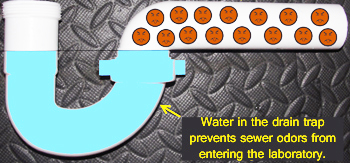What' that Smell?
 Have you noticed a periodic odor in your laboratory but you cannot seem to be able to identify it? Does it smell like decay or have a sewer smell or other indescribable stinky odor? If so, you may be smelling the sewer through a dry drain trap. Have you noticed a periodic odor in your laboratory but you cannot seem to be able to identify it? Does it smell like decay or have a sewer smell or other indescribable stinky odor? If so, you may be smelling the sewer through a dry drain trap.
Drain traps use water to serve as a barrier to prevent sewer odors from coming back into the laboratory. These traps are often called P traps. The figure below demonstrates a P trap that is properly filled with water. As you can see in the photograph the water contained within the dip in the drain prevents gasses from returning back into the building.

Compare the picture above to the demonstration below of a drain trap that does not contain an adequate volume of water to act as a barrier. As you can see, without the water barrier in place sewer gasses can now enter into the building.

Fume hood use and other fluctuations in room pressure often result in the sporadic nature of the odor. For example, our laboratories are also under negative pressure which makes it even easier for sewer gasses to enter and if you raise a fume hood you can increase the likelihood of sewer gasses being drawn into the laboratory because of the increased negative pressure.
The remedy to the problem is simple, keep water in the drain trap. You should run at least on liter of water into the drain periodically to maintain the appropriate water level. Keep in mind that water will evaporate from the drain traps more quickly in the dry winter months.

If the sink is seldom used then we recommend pouring about 25ml of mineral oil or baby oil into the drain. The oil will separate from the water and rise to the top which will form an oil layer on top of the water in the drain trap and will help prevent the evaporation of the water below it.
The other issue is locating all your sinks. Laboratories can be full of cup sinks and floor drains. Many times the cup sinks are hidden by equipment. Be sure to identify all the drains in your laboratory. On rare occasions we have found floor drains or drain lines behind fume hoods and other structures that were missed during renovation so if you continue to smell a sewer odor and you cannot find a drain please contact the Office of Environmental Health and Safety at 274-2005.
|